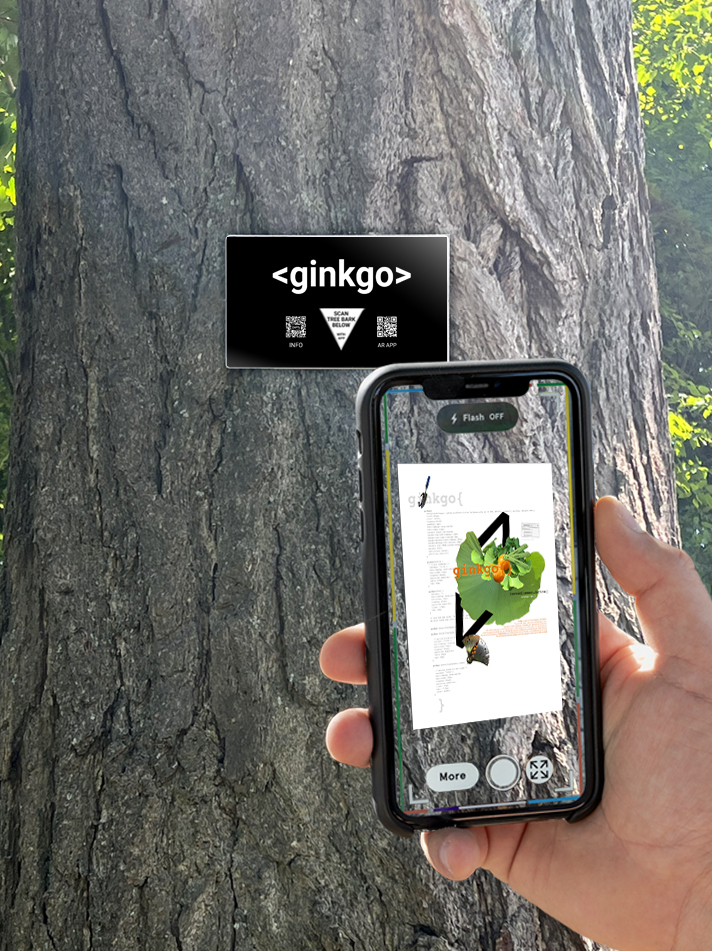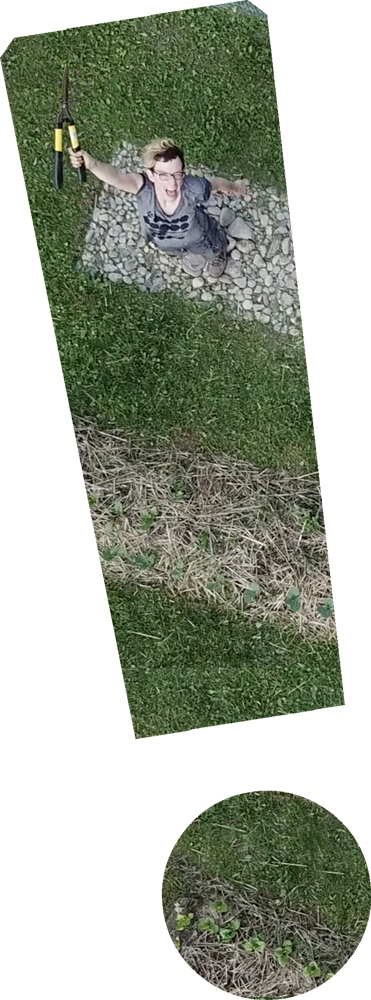Custom HTML Plant Tags are a digital image series accessible through an Augmented Reality
experience by scanning the bark of trees, reading their structure as “natural” QR code. Visitors,
with their cellphone and AR app in hand, take a stroll around the island to treasure hunt digital
files “embedded” within natural trees.
DATES AND TIMES: June 30 – October 29, 2023
Open to the public Friday, Saturday and Sunday 11 – 5 pm
Artist Day: September 23, 2023
Walks & Talks by Ursula: Saturdays at 2:30 and 4:30
LOCATION: Harvestworks Art and Technology Program Building 10a, Nolan Park, Governors Island and outdoors in Nolan Park at five trees
Custom HTML Plant Tags merge the history of taxonomic drawings – biological layouts of
different plants and their characteristics – with the organizational structure of HTML elements
for creating web pages, creating new categories between botany and code. Exploring and
questioning methods of categorization, custom created HTML tags such as <ginkgo> or
<legume> are placed as “botanical” seeds into the Web code, invoking a closer relationship of
digital and biological structures. The code that is visible in Custom HTML Plant Tags is part of
the actual computer program that runs a –“reversed” – version of the project: Input Field
reversal #3.
Input Field reversal #3 (IFr3) reflects on the behavior, morphology, and intelligence of plants
applied to digital interfaces. Algorithms, modeled after how IRL plants are affected by
environmental changes, execute that behavior within their digital equivalents. The shapes of
these digital counterparts are web-based user interfaces, pull-down menus to be precise
scripted in HTML, CSS and Java-Script, which respond to weather like plants would in happiness
or distress: too much humidity calls for blights, too hot and dry weather and they wilt and
might die.
IFr3 invites into a bird’s eye view of Governors Island’s surroundings, more specifically to Nolan
Park and the same five trees featured in the AR work. Activated by the visitor each tree (or seed
or interface) in this browser-based garden goes through a brief growth cycle, depending on
current weather and the visitor’s care and digital “gardening” capabilities, and culminates in a
harvest consisting of questionable depictions of naturally grown, web-coded, and AI-assisted fruits.
BIO:
URSULA ENDLICHER is a new media and interdisciplinary artist working with interactive media and the Internet since the early 1990s. She investigates structural components and interfaces of digital and “natural” networks and creates works in contrasting formats including net art, AR, installation, performance, environmental works, and dinners – often a combination thereof. In her works humans and more-than-humans, machines and nature, are inspired by each other’s behavior – often in humorous ways – and create new forms and “worlds” in between.
Thematizing the interplay of digital and natural resources she uses diverse media and materials such as code, environmental real-time data, video, ceramics, plants and food, stimulating the audience’s conceptual and multi-sensory perceptions. Her work has been shown at Chronus Art Center, Shanghai; Haus der Elektronischen Künste, Basel; Transmediale, Berlin; SIGGRAPH, Yokohama; Eyebeam, New York; Castle Centre for Contemporary Art, Warsaw; and WUK, Vienna. Her work is part of the artport collection of the Whitney Museum of American Art.
https://www.ursenal.net/
https://www.instagram.com/ursulaendlicher/
https://www.facebook.com/urs.ula.end.licher/
PRESS QUOTES:
1. “Ursula Endlicher, another intriguing artist, draws connections between analog, digital, and virtual worlds, with no firm boundary between them. With humor, she will, for example, translate the “hidden” language of the Web’s HTML code into choreographed performances, effectively crossing boundaries between the living and non-living and between the visual and lingual. In her system, a fiddlehead fern might serve as an “@” sign. Her purpose, however, is to demonstrate reciprocity—how coding might affect nature and nature might affect coding. There are two components to her work: the actual field that she cultivates and the computer screen where she has the viewer flesh out all the characteristics affecting that effort. Input Field Reversal (and Custom HTML Plant Tags) (2021) is an example of an installation that addresses reciprocity. In it, she demonstrates how if she changes criteria, such as humidity, on the computer, it will indicate the impact of that change on the environment. She can then decide whether to implement changes within the cultivated field.“
From: Sculpture Magazine. “Beyond the Art/Science Duality: A Conversation with Ellen K. Levy” by Joyce Beckenstein/ December 8, 2022
Link: https://sculpturemagazine.art/beyond-the-art-science-duality-a-conversation-with-ellen-k-levy/
2. “We minted one NFT with the artist Ursula Endlicher, who is part of our current exhibition “Earthbound: In Dialogue with Nature.” She has created a digital interface in the exhibition space, which is about ecology and the trees on the square outside HEK. By using an AR app, you can go outside and scan the bark of the tree, then access the NFT. It links physical and digital space.”
From: Outland.art. “Collections HEK”. By Brian Droitcoeur (In conversation with Sabine Himmelsbach / HEK Basel). November 22, 2022
Link: https://outland.art/hek-collecting-software-art/
3. “The work of the artist Ursula Endlicher from New York also invites interaction: A screen shows a drone image of the area in front of the HEK. The effects of different weather conditions on the trees standing there can be simulated using a touchpad. So you have it in your own hands whether the trees die or bring a rich harvest. Outside, the bark of the real trees can be scanned with a smartphone like a QR code. Anyone who does this receives the code of the virtual tree as an image ”
(Google Translation from German) From: Das Wochenblatt, Basel. “Anfassen Erlaubt” by Tobias König. September 7, 2022
Link: https://www.wochenblatt.ch/wob/aktuell/muenchenstein/artikelseite-muenchenstein/?tx_ttnews%5Btt_news%5D=108898&cHash=deedd6ae7ebf66b5e3b8019308c0aa86








